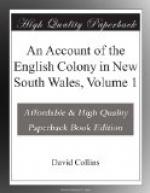{Thus far Lieutenant-Governor King.}
From the 25th of October, the day on which the ships made sail from Norfolk Island, till the 31st of the same month, nothing material occurred. On that day Mr. Raven stated to Captain Waterhouse, the commander of the Reliance, the necessity there was for the Britannia’s making the best of her way to England; and as he thought she sailed rather better than that ship, he requested permission to part company, which Captain Waterhouse not objecting to, we separated and made sail from them.
On the 5th of November we passed an island named by Lieutenant Watts (who first saw it in the Lady Penrhyn transport) Macauley Island.
Sunday the 6th was passed in examining an island, which Mr. Raven was decidedly of opinion had never been seen before. It was situated in the latitude of 29 degrees 15 minutes and longitude of 181 degrees 56 minutes E. We found the land high, and it appeared to be well covered with wood. On the south-west side of it is a bay in which, from the colour of the water, Mr. Raven thought there was good anchorage; but at this time there was too much surf breaking on the beach to render it prudent to send a boat in. The aspect on this side of the island was romantic and inviting; but on the other side the shore was bold, and in many parts rugged and bare. The whole appeared to consist, like Norfolk Island, of hills and dales. We conjectured that there was fresh water in the bay on the south-west side. The knowledge of the existence of this island can be of no other importance, than to cause navigators sailing in that route to keep a good look-out, particularly in the night-time, as many straggling rocks lie off the north side.
From the circumstance of its being seen on a Sunday it obtained the name of Sunday island.
Leaving this, we proceeded toward Cape Horn; but it was not till the 16th of December that we saw the southern part of the vast continent of America. Mr. Raven intended to have made the Jasons, and touched at Falkland’s Islands in the hope of procuring some information respecting the Cape of Good Hope; but, after passing Cape Horn, and finding the wind hang to the northward, he altered his course for the Island of St Helena, or the Cape of Good Hope, as circumstances might direct.
On the 21st, in latitude 51 degrees 56 minutes S and longitude 306 degrees 25 minutes E to our great surprise, we fell in with and joined our companions the Reliance and Supply. We found that, by keeping nearer to the north end of New Zealand than we had done, they had met with more favourable winds. We now proceeded together toward the Cape of Good Hope.
On the 23rd, being about the latitude of 50 degrees S we fell in with several islands of ice; which, however, we cleared without any accident, and stood more to the northward. Mr. Raven was of opinion, that ice would always be found in or about those latitudes, and recommended that all ships, after passing Cape Horn, should keep more to the northward than we did.




